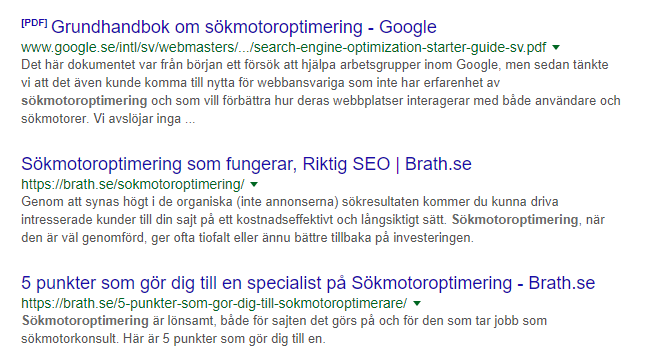
We are facing a major change in the SEO world. You will need to be prepared for it if you want to be able to do search engine optimization.
Search engine optimization has worked more or less the same over the years. Google uses the same foundation for building search results now as in 2007. Content and links have been the main factors, as long as you have the technical setup in place. This will continue to be the case for the foreseeable future, but the way these factors are viewed has changed significantly and greater changes are coming.
User intent plays a much bigger role
For at least a year, we have seen clear indications that user intent plays an increasingly important role in what is shown. In the search results for SEO, which without a doubt is one of the most competitive in our industry, we at Brath have held the first place (some days the second) with the site SEO.n.nu. This is a site that neither has the content nor the links to deserve such a position. The content isn’t bad, but it’s simply not nearly as comprehensive as on this site or any of the competitor sites that focus on it.
Another example is our article 5 points that make you an SEO which for a few days reached top ten on the keyword Search Engine Optimization, together with our page on SEO. It is of course a good article if you want to become an SEO, but honestly it’s not an optimized article for that keyword, it was written to be interesting for the readers of this blog (only). I wouldn’t guarantee the article will stay in the top ten, but the fact that it shows up there at all is a good indication. Below you can see a screenshot of how it looks in different places around the country, feel free to double-check yourself and tell me – it varies a lot depending on geography.
The article had never had positions in that search result before, it was rather other pages on this site that showed up there. During the two and a half years the page had existed on the site, it had never, until now, shown signs of ranking there. It doesn’t have many internal links except through the blog’s pagination (weak) and it is not optimized in terms of text and headings. Yet Google wants to show it.
Both of these cases have one single characteristic that sets them apart from the rest of the pages in the results. They speak to a different type of user. All the other pages (with a few half-hearted exceptions) in the search results are very commercial – they want to sell a service to the visitors. These two pages, however, either teach SEO or provide information to aspiring SEOs.
Google is far ahead in the AI race
Brath.se has developed well in the search results over the past year. From already good positions the site has climbed broadly during 2017, or since July 2016 to be exact. It hasn’t been as stable as before, something I assume most SEOs recognize today. What did we do in July 2016 that started this upward curve? It’s not like we just started doing SEO then. The truth is, we didn’t do anything differently.
What happened is that Google updated its algorithm a long series of times, and it is my personal conviction that what lies behind our big successes in 2017 is something that started already in October 2015 when RankBrain first saw the light of day. RankBrain is the “AI” that quickly became the third most important factor when Google creates search results. The reason AI is in quotes is that I wouldn’t call it true AI – it’s a foundation for AI but not actual artificial intelligence. It’s really a self-learning algorithm, and it learns what users want when they search for a certain phrase.
My impression is that the two current search results were crying out for content that was educational rather than sales-oriented. Google themselves talk about three types of user intent: Do, Know, and Go.
Three types of search intent
- Do, often called Transactional. When the searcher wants to do something: buy, download or register. An example might be “SEO quote”.
- Know, or informational. Where the goal is to learn something. A classic example is “How to do SEO”.
- Go, or navigational, when you want to reach a specific page and use Google to get there. It’s no coincidence that the biggest search term in Sweden is “Facebook”.
The examples above are clear searches where it’s obvious what the average searcher wants. But what about a keyword like SEO or Search Engine Optimization? Here it’s not nearly as clear, but we humans (who actually have brains, unlike Google) can figure out that a relatively large share are looking to understand what it is or to learn. This is where Google’s RankBrain comes in. By measuring and understanding user intent, Google can adjust the search results to fit these users – without losing those searching with the goal of finding professional help.
Easy to confuse with user data
What we should remember about Google’s algorithms is that they are cautious about user data, to some extent. The page currently showing up on “SEO” doesn’t have enough user data, even if that were Google’s metric – it simply hasn’t had visitors since it was written. Above you can see a graph from when the article was published until today. Its best day in 2017 had 8 pageviews, none from search. To be clear, the page has no external links according to Search Console. Until now, it has been a forgotten article in this blog’s history.
User data is the foundation, but not the ranking factor. Our view is that RankBrain is smarter than just using raw user data. In the same way as both Panda and Penguin used user data to build the algorithm but not to rank directly, we are convinced that RankBrain uses user data to learn what content is good – but not to rank it.
With the exception that it might be a combination. Many SEOs claim Google sometimes tests search results live. By showing a page, they can get data on how it performs, and thus it may keep, improve, or lose its position. That would work like this: Google surfaces a page the algorithm believes deserves top ten, then tests it live. If the CTR is high, bounceback low, and little pogo-sticking happens, then it keeps its spot. This may well be true.
It doesn’t work for everyone
Not all sites are equally valuable. In this case it’s extra clear. Google shows that 259,000 results could exist for SEO, and honestly I doubt I’m such a divinely gifted writer that I managed to write two articles that both deserve top ten only because of content. Of course, there are plenty of articles as well written as mine – but it’s specifically mine that rank, and the reason is simple: they’re on this site.
Don’t forget that RankBrain is the third most important factor, according to Google. By being published on this site and being reasonably structured from an SEO perspective, the article has the chance to appear like this. On a site with less authority or weaker structure, it wouldn’t.
Whether the page stays in the results tomorrow or next week remains to be seen. Honestly, I doubt it – but I’d be happy to be proven wrong. What the page does show is how far Google has come with AI and how much they let it influence results. You will have to adapt to RankBrain, or some other AI-like algorithm, if you want to do SEO. Google has shifted from Mobile First to AI First. You probably should too.
Further reading
If you’re interested in more on the subject, I’d recommend the following links:



